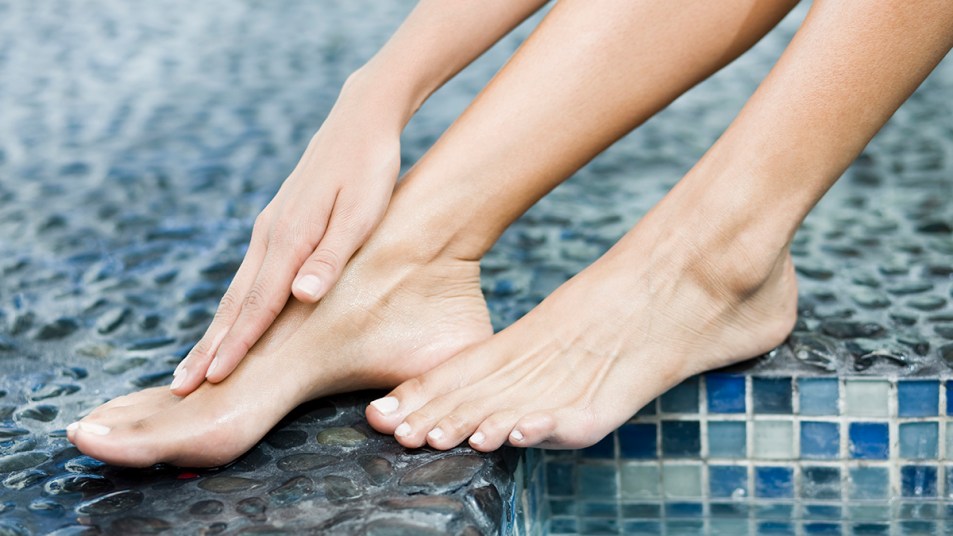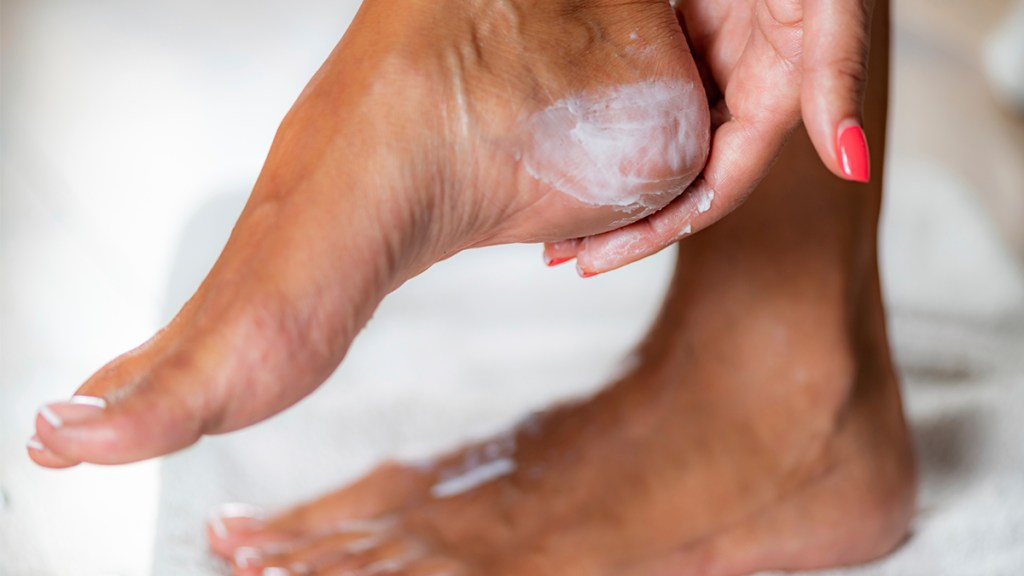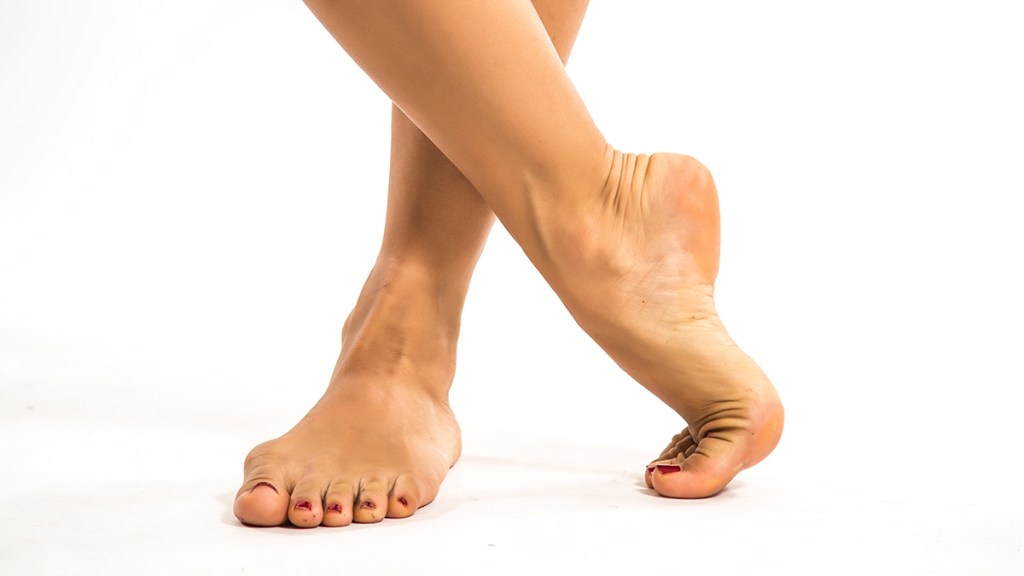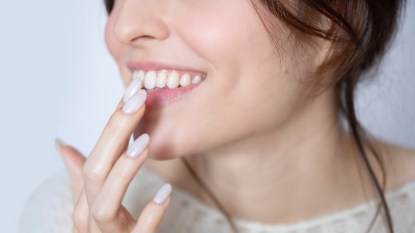Foot Pain is the Menopause Symptom No One Warned You About: How to Relieve It
Podiatrists explain why this happens and easy ways to sidestep the discomfort for good!

Sudden hot flashes, tossing and turning at night, mood swings, down-there dryness, incontinence — you know all about these menopause symptoms. But aching feet? No one told us sore feet might be a result of menopause! But as it turns out, menopause foot pain is real — and surprisingly common. And while it’s easy to blame our shoe choices for the pain, it turns out hormones are to blame for the majority of menopausal foot pain. We tapped podiatrists and functional medicine specialists to get you the whys of this pain and the hows of easing it.
Understanding menopause foot pain
Women suffer four times more foot pain than men, says podiatrist Doug Tumen, DPM, author of Ask the Foot Doctor. And it gets worse as we age. “That’s in large part because fluctuating estrogen levels as women get older can weaken ligaments in the foot,” explains Dr. Tumen. What’s more, adds Susan Blum, MD, functional medicine expert and founder of the Blum Center for Health in Rye Brook, New York, “Women over 50 tend to experience more aches and soreness because when our ovaries go ‘off line,’ the dip in estrogen triggers painful inflammation, especially where daily wear and tear on the body is greatest.”
But it’s not just estrogen that plays a role. Read on for more causes of foot pain and easy remedies for each one:
Decreased collagen can cause menopause foot pain
Collagen drops by 30% in the first five years of menopause. After that, the decline slows down a bit, but we still lose an additional 2% per year. That’s a problem when it comes to our feet, says Michael Nirenberg, DPM, a podiatric physician in Crown Point, Indiana. He explains, “When estrogen levels drop during menopause, it causes a decrease in the production of collagen — a matrix of elastic tissue that’s crucial for keeping the feet’s supporting structures strong.” Depleted collagen means the tendons and skin in your feet are tighter and blood vessels are more constricted, increasing the odds of injury or pain.
Foot-pain fix: Boost collagen levels
As collagen production slows down in menopause, research published in Amino Acids indicates collagen supplements reduce pain and improve joint function. A hormone- and pesticide-free brnd to try: Trace Minerals Grass-Fed Collagen Peptides (buy at traceminerals.com $42.99). Also smart: focus on eating foods that are good sources of collagen or those that support collagen production, such as bone broth, leafy greens, legumes and citrus fruits.
(Click through for more on the painkilling benefits of marine collagen, a less popular, but arguably more powerful, type of collagen. For more on bovine collagen, check out collagen’s many benefits for women.)
Poor circulation can cause menopause foot pain
Those dipping estrogen levels can increase stiffness in your arteries, reducing blood circulation, according to a 2020 study published in Arteriosclerosis, Thrombosis, and Vascular Biology. Along with impacting your heart health, the limited blood flow caused by poor circulation starves your feet of nutrients, blood and oxygen, says natural pain-relief expert Heidi Weinhold, ND, managing partner for Appalachian Botanical Company, in Canonsburg, Pennsylvania. “That can lead to foot pain, as well as tingling, numbness or muscle cramps.”
Foot pain fix: A healing balm

A little pampering can go a long way to easing your aching feet, says Dr. Weinhold. Her favorite remedy: Massage a bit of Arnicare Footcare Cream (Buy at mysupplements.store $16.68 for a 4.2 oz. bottle) into your feet at bedtime to help relieve swelling in the feet and lower legs. The homeopathic remedy is believed to have analgesic and anti-inflammatory properties, says Dr. Weinhold, the former legislative chair for the Pennsylvania Association of Naturopathic Physicians.
Weak bones can lead to menopause foot pain
Some 8 million women in America suffer from osteoporosis, and the risk rises with age. The most common cause of osteoporosis? Menopause — and it leaves your feet at a higher risk of stress fractures as well as foot pain caused by ordinary wear and tear that’s difficult for weakened bones to endure.
Foot-pain fix: Load up on vitamin K

Leafy greens like spinach, kale and broccoli are rich in vitamin K, and a study of over 1,400 older women in Australia found that women who ate 100 micrograms or more of this nutrient a day reduced their fracture risk by 31%. Nutrition experts Mira Calton, CN, and Jayson Calton, PhD, explain that vitamin K plays an important role in bone health, activating proteins involved in bone formation and mineralization and say you can get that dose of vitamin K by eating one to two daily servings of K-rich foods.
Also smart: Add some salt to your coffee, says nutritionist Daryl Gioffre. “Getting enough salt is critical for keeping our bones strong, especially for women who are having challenges with osteoporosis or osteopenia,” says Gioffre, author of Get Off Your Acid. “You want to add healthy salts that kick the acid and alkalize your body,” he says. “I suggest adding a quarter teaspoon or a generous pinch of Himalayan salt or baking soda to your coffee right after brewing, because when your coffee is hot, it will make the salt dissolve faster and easier.” (Click through for more foods and exercise to prevent osteoporosis.)
Fallen arches can cause menopause foot pain
Women with menopause foot pain whose feet tire easily or are swollen on the inside bottom likely have fallen arches — a condition in which the tendons of the foot become lax and lose height. It can occur in one foot or both and can lead to plantar fasciitis, or painful inflammation along the entire sole of the foot.
Foot pain fix: the “short-foot” exercise

To ease and prevent the pain caused by collapsed arches, experts recommend the “short-foot exercise,” which has been shown to improve foot flexibility and function. To do: Take off your shoes and stand with both feet flat on the floor, then raise the arch of your foot by sliding your big toe toward your heel — without curling your other toes or lifting your heel. Hold for 8 seconds, then relax. Repeat four times. Researchers advise doing the exercise first thing in the morning, then repeating at least twice a day, but if your arches are very sore, you can minimize discomfort by doing fewer repetitions for the first week or two.
To build arch strength even faster, consider insoles, which ease pain while keeping arches from collapsing further and have been shown to ease the pain of plantar fasciitis. (Click through for the best insoles for plantar fasciiitis.)
Finally, consider trying Dr. Weinhold’s trick of massaging castor oil on the bottom of your foot nightly, using a roll-on product like Baar Products Roll-on Castor Oil. (Buy on Amazon, $15.75 for a 3-oz bottle.) The anti-inflammatory, antioxidant-rich oil is study-proven to ease pain. “Relief should occur within three or four nights of use.” (Click through for more benefits of castor oil.)
Weight gain can cause menopause foot pain
Your body naturally produces less estrogen as you age, so your fat cells kick in to store excess estrogen in abdominal fat to compensate, adding unwanted pounds that your feet have to carry around all day. But there’s good news: In a study published in Arthritis and Rheumatism found losing just 1 pound removed 4 pounds of pressure on the knees, lower legs and feet. “In other words, shedding 10 pounds would relieve 40 pounds of pressure from your knees and lower legs,” explains Edna Skopljak, MD, medical advisor with Health Reporter.
Foot-pain fix: a posture tweak
First, Dr. Skopljak advises ensuring you’re eating plenty of cruciferous and dark green vegetables, lean protein and healthy fats like olive oil and avocado, which help with hormonal balance and weight loss. But she also recommends wearing a posture-correcting device, like the ComfyBrace Posture Corrector (buy on Amazon, $21.97). “Because weight gain in menopause can be sudden, many women alter their gait or posture, which further triggers menopause foot pain.” But wearing a posture-correcting device throughout the day, and especially when walking, can put an end to pain-inducing slouching.
This content is not a substitute for professional medical advice or diagnosis. Always consult your physician before pursuing any treatment plan.
For more on how to ease foot pain, click through the links below!
Good News: You Can Dodge The Top Cause of Foot Pain With This Simple Daily Routine
The Surprising Link Between Estrogen and Foot Pain
“This Healed My Painful Bunions — And You Won’t Believe the Before and After!”













